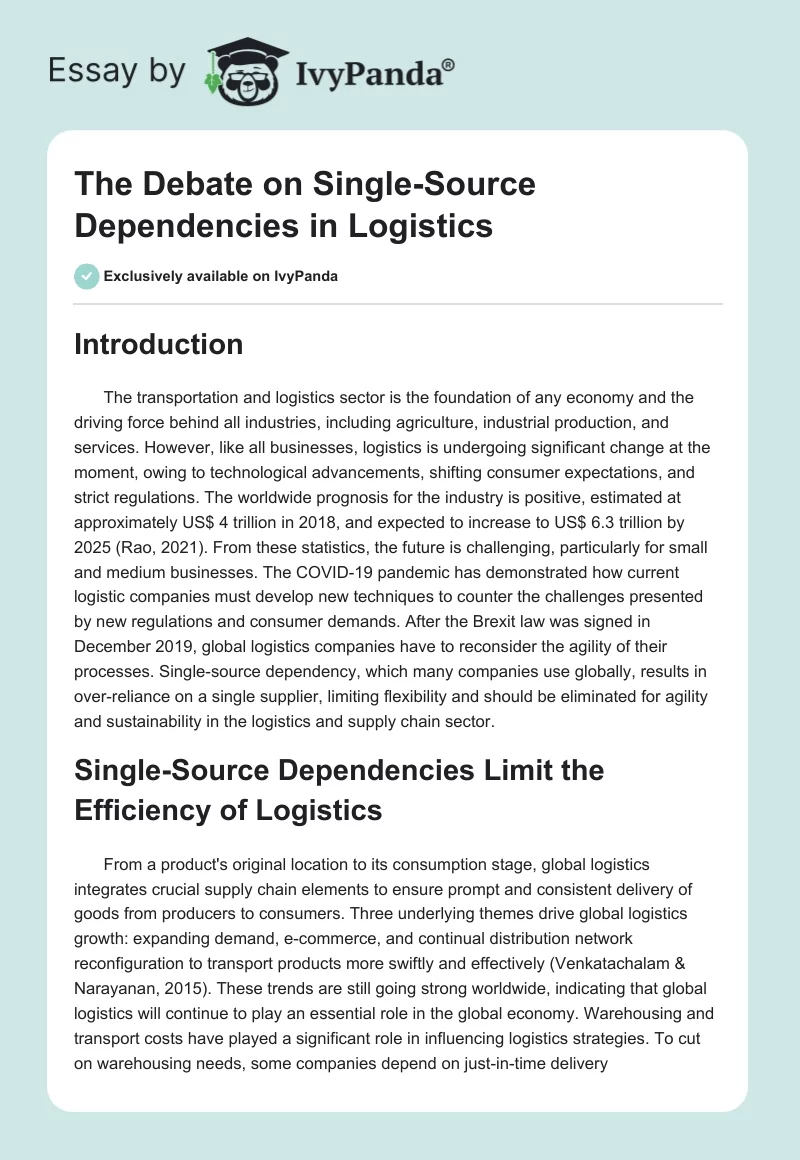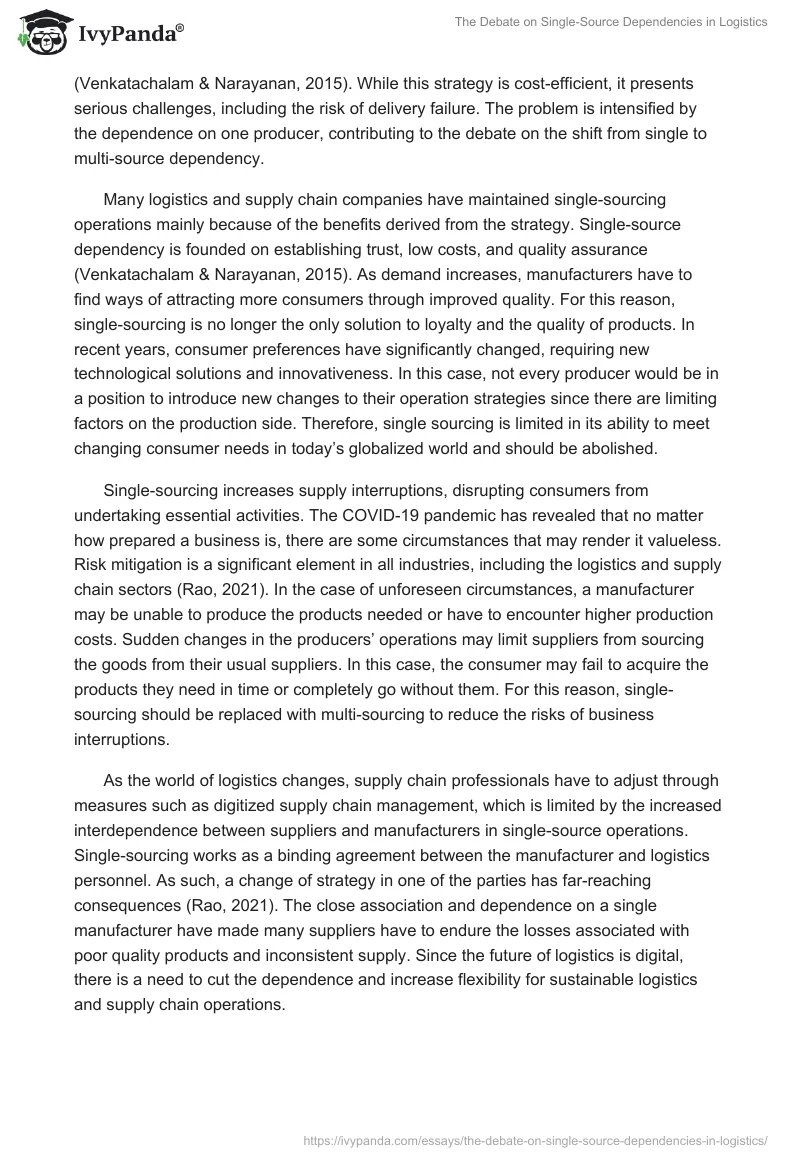Introduction
The transportation and logistics sector is the foundation of any economy and the driving force behind all industries, including agriculture, industrial production, and services. However, like all businesses, logistics is undergoing significant change at the moment, owing to technological advancements, shifting consumer expectations, and strict regulations. The worldwide prognosis for the industry is positive, estimated at approximately US$ 4 trillion in 2018, and expected to increase to US$ 6.3 trillion by 2025 (Rao, 2021). From these statistics, the future is challenging, particularly for small and medium businesses. The COVID-19 pandemic has demonstrated how current logistic companies must develop new techniques to counter the challenges presented by new regulations and consumer demands. After the Brexit law was signed in December 2019, global logistics companies have to reconsider the agility of their processes. Single-source dependency, which many companies use globally, results in over-reliance on a single supplier, limiting flexibility and should be eliminated for agility and sustainability in the logistics and supply chain sector.
Single-Source Dependencies Limit the Efficiency of Logistics
From a product’s original location to its consumption stage, global logistics integrates crucial supply chain elements to ensure prompt and consistent delivery of goods from producers to consumers. Three underlying themes drive global logistics growth: expanding demand, e-commerce, and continual distribution network reconfiguration to transport products more swiftly and effectively (Venkatachalam & Narayanan, 2015). These trends are still going strong worldwide, indicating that global logistics will continue to play an essential role in the global economy. Warehousing and transport costs have played a significant role in influencing logistics strategies. To cut on warehousing needs, some companies depend on just-in-time delivery (Venkatachalam & Narayanan, 2015). While this strategy is cost-efficient, it presents serious challenges, including the risk of delivery failure. The problem is intensified by the dependence on one producer, contributing to the debate on the shift from single to multi-source dependency.
Many logistics and supply chain companies have maintained single-sourcing operations mainly because of the benefits derived from the strategy. Single-source dependency is founded on establishing trust, low costs, and quality assurance (Venkatachalam & Narayanan, 2015). As demand increases, manufacturers have to find ways of attracting more consumers through improved quality. For this reason, single-sourcing is no longer the only solution to loyalty and the quality of products. In recent years, consumer preferences have significantly changed, requiring new technological solutions and innovativeness. In this case, not every producer would be in a position to introduce new changes to their operation strategies since there are limiting factors on the production side. Therefore, single sourcing is limited in its ability to meet changing consumer needs in today’s globalized world and should be abolished.
Single-sourcing increases supply interruptions, disrupting consumers from undertaking essential activities. The COVID-19 pandemic has revealed that no matter how prepared a business is, there are some circumstances that may render it valueless. Risk mitigation is a significant element in all industries, including the logistics and supply chain sectors (Rao, 2021). In the case of unforeseen circumstances, a manufacturer may be unable to produce the products needed or have to encounter higher production costs. Sudden changes in the producers’ operations may limit suppliers from sourcing the goods from their usual suppliers. In this case, the consumer may fail to acquire the products they need in time or completely go without them. For this reason, single-sourcing should be replaced with multi-sourcing to reduce the risks of business interruptions.
As the world of logistics changes, supply chain professionals have to adjust through measures such as digitized supply chain management, which is limited by the increased interdependence between suppliers and manufacturers in single-source operations. Single-sourcing works as a binding agreement between the manufacturer and logistics personnel. As such, a change of strategy in one of the parties has far-reaching consequences (Rao, 2021). The close association and dependence on a single manufacturer have made many suppliers have to endure the losses associated with poor quality products and inconsistent supply. Since the future of logistics is digital, there is a need to cut the dependence and increase flexibility for sustainable logistics and supply chain operations.
Opposing Views
Although single-sourcing has been found insufficient to handle customer requirements in today’s globalized supply chain, some experts feel that abolishing it might not be the right strategy. Inconsistent quality has been cited as one of the challenges that might be experienced due to multi-sourcing operations (Namdar et al., 2017). Having many sources may limit the supplier’s ability to keep track of each producer’s quality, which may lead to compromised quality. In essence, product quality is undeniably the most crucial driver of success in the supply chain sector. Therefore, compromised quality arising from multi-sourcing would lead to some companies being thrown out of the market, which is a major drawback. Therefore critics argue that suppliers should find ways to handle the challenges of single-sourcing without altogether abolishing it.
Cost minimization is another major factor associated with the use of single-sourcing strategies. Getting all products from one producer has the benefit of reduced costs because the parties involved have established some level of trust. In some cases, the supplier may even get products on credit, meaning that they are assured of supply even if they encounter financial challenges. According to Namdar et al. (2017), multi-sourcing would introduce new costs that would significantly affect the supply chain efficiency. Therefore, critics of the abolishment of single-sourcing argue that the plan would lead to more losses and, therefore, not worth attempting. In response to the opposing view raised, the logistics and supply chain experts need to understand that multi-sourcing would actually encourage producers to improve on product quality to counter competition. Therefore, the proposition for the abolishment of single-sourcing techniques remains valid and the best solution to sustainability challenges in logistics.
Conclusion
In conclusion, the logistics and supply chain industry is the backbone of every country’s economy. Recently, this sector experienced challenges that prompted experts to consider ways of enhancing agility and sustainability in the supply chain operations. The single-sourcing strategy is one of the factors that has been seriously scrutinized, with experts arguing for its abolishment. Single-sourcing has rendered suppliers incapable of meeting changing customer requirements. In addition, the dependence on one producer has limited suppliers’ flexibility and reduced sustainability in the industry. Critics argue that if single-sourcing is abolished, costs would increase and contribute to low-quality products. Both of these probable challenges can be handled by increased competition resulting from multi-sourcing strategies. In essence, the future of logistics lies in flexibility and enhanced technological solutions. These factors can only be achieved if single-sourcing is replaced with multi-sourcing techniques globally.
References
Namdar, J., Li, X., Sawhney, R., & Pradhan, N. (2017). Supply chain resilience for single and multiple sourcing in the presence of disruption risks.International Journal of Production Research, 56(6), 2339-2360.
Rao, A. (2021). Exploring the factors for enhancing supply chain responsiveness in the logistics industry: a case study of select logistics companies in Delhi NCR Region.International Journal of Indian Culture and Business Management, 24(2), 214.
Venkatachalam, S., & Narayanan, A. (2015). Efficient formulation and heuristics for multi-item single-source ordering problem with transportation cost. International Journal of Production Research, 54(14), 4087-4103.


